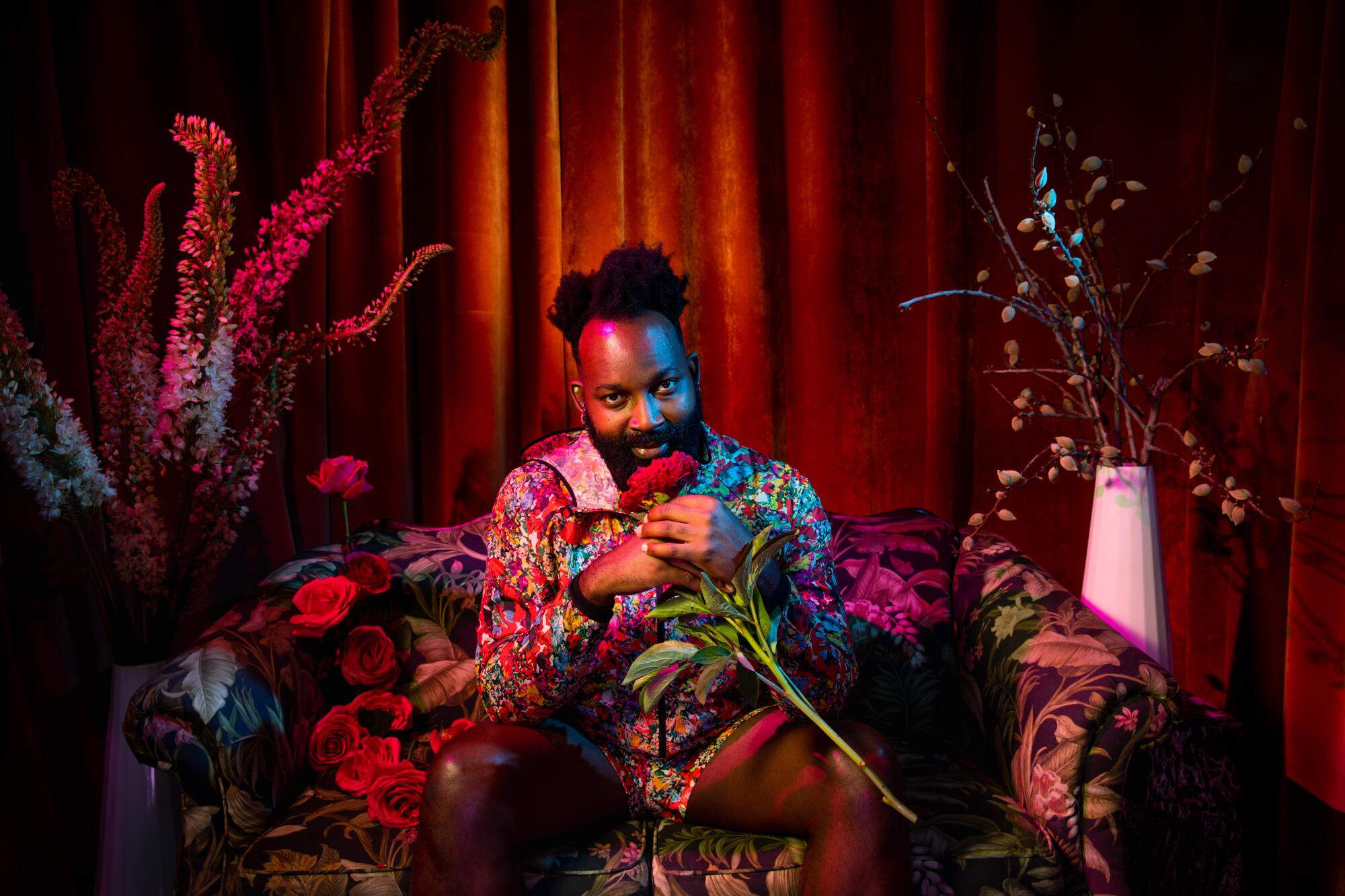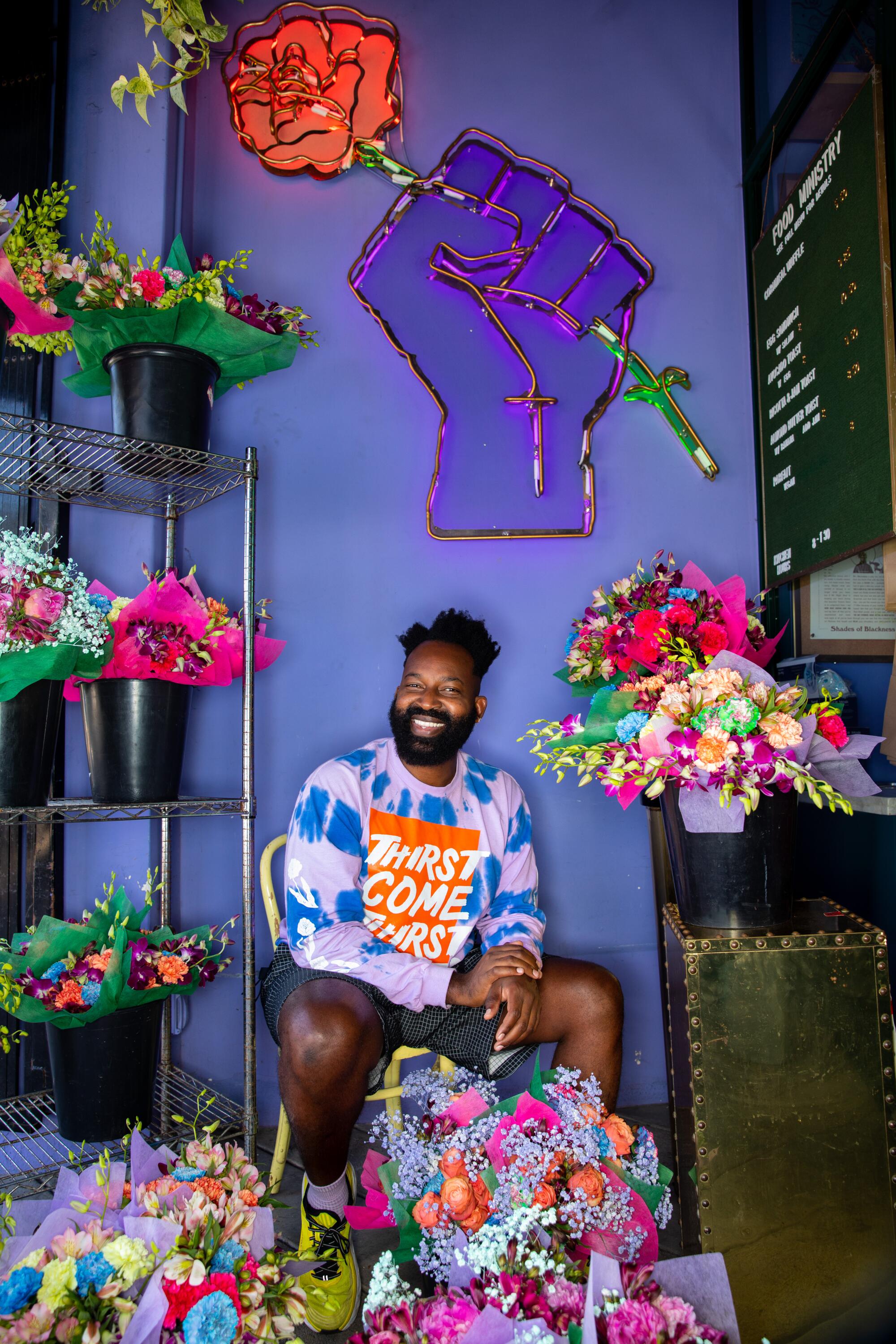
- Share via
A week after the shocking and brutal killing of George Floyd, Maurice Harris found himself holding a pickax, digging furiously into the dirt field outside his Echo Park apartment for the first time in 16 years. As protests sprang up across the country, Harris desperately needed an outlet for his inner rage.
Anger wasn’t an emotion he often expressed as a floral artist known for both his vibrant, surrealist, sculpture-like arrangements and his exuberant personality. Working for celebrities and luxury brands including Louis Vuitton, Goop and Valentino, Harris had learned to make his high-income, and typically white, clientele comfortable.
He had also cultivated a personal and professional brand focused on luxury, Black excellence and tackling social issues with “beauty, grace and fun.”
But in that moment, he was fed up with the balancing act.
“When you see someone that looks like you, a Black male body just treated like it doesn’t matter, it just kind of shatters all the work that you feel like you’ve done,” he said over Zoom.
The frenzied digging eventually became a garden, where Harris is growing herbs, berries, black watermelon, plenty of flowers, trees and vegetables. Converting the dirt into a garden is yet another manifestation of what he calls his life thesis — the foundation of his art practice and the guiding principle of his business Bloom & Plume — converting ugliness into beauty.
“I’m obsessed with aesthetics. I’m obsessed with beauty,” said Harris, 39. “I think that obsession comes from an extreme point of pain and sadness and isolation.”
A list of our favorite Black plantfluencers, plant stylists, floral artists, enthusiasts, experts, and garden store owners on Instagram.
Like many who’ve seen the frantic pace of their lives grind to a crawl during the COVID-19 pandemic, Harris is now, for what he said is the first time in his adult life, resting. In addition to working on the garden, he also got a black standard poodle puppy, formerly known as Latrice, now named Leroy. (Black, “because Black lives matter,” he added.)
The time to reset and focus on mental health is much needed.
Harris created Bloom & Plume, a floral design studio and cafe in historic Filipinotown. He manages his social platform with more than 200,000 followers. He once taught a popular dance class at Ryan Heffington’s the Sweat Spot and has shown work at the Museum of Contemporary Art and the San Diego Art Institute.
He’s the host of a new dreamlike Quibi talk show, “Centerpiece,” where he interviews Black creatives and interprets their personalities into elaborate floral installations. He will be a judge on an upcoming HBO Max competitive floral show called “Full Bloom.”
Oh, and he can finally reveal that he was a floral designer on Beyoncé’s new visual album, “Black Is King.”

“I kind of can’t sit still, but I need to sit my ass down and have several seats,” he said. “I’m trying to learn how to do that.”
Harris’ relentless pursuit of perfection and aversion to being pigeonholed is a byproduct of his childhood in Stockton, Calif., where he grew up in church and in majority-white schools.
A family member recently sent him a picture from Easter when Harris was about 5 and had the nickname “Man,” for his adult-like attitude. “I had on my suit. I have my sunglasses. I look like, ‘Bitch, you can’t tell me nothing.’ I just look so bomb,” he said. “I’ve always been this kind of larger-than-life person.”
Harris — whose mother is a musician and crafter and whose grandmother made floral arrangements and hats — was encouraged to be creative and began decorating his home as a child. But his upbringing was constantly at odds with his identity.
“Something about my existence was problematic,” Harris said. “I’ve been on this journey my whole life trying to justify my existence. And I think I’m a pretty beautiful person inside and out.”
Harris’ younger brother and business partner, Moses, said he’s always looked to his brother as a superhero, even though Harris was often suppressed at home. “He was definitely not celebrated for his obscure perspective on things,” Moses said.
Moses thought back to when Harris wanted to join his school’s color guard team, typically seen as a girls-only activity.
“My dad shut that down immediately,” Moses said. “So in true Maurice fashion, Maurice found a way to be great in a form that allowed him to express his art. So he became the best drum major in our school history, actually the best drum major in the state.”
After graduating from Otis College of Art and Design’s fine arts program, Harris worked for Barneys New York and Juicy Couture designing window displays. He became the go-to person for creating floral designs at work events, which then led to one-off freelance gigs.
“I chose flowers as a medium because it’s a commercial craft, often looked at as craft, but I tried to take it to a level that becomes ephemeral art.”
— Maurice Harris
When he was laid off from Juicy Couture, Harris launched Bloom & Plume in 2010 and began building a roster of celebrity clients. Although Harris wanted to keep his business a bit mysterious, he found that potential clients wanted a website where they could see his arrangements.
But photographing flowers was difficult and boring, he said. The images are often flat, unable to capture the complexity of his arrangements.
That’s where Instagram came in: “You put a Valencia filter on it and now you got a lot of magic,” he said.
A scroll through Harris’ Instagram is a peek into what he calls his natural opulence aesthetic.
Inspired by the account She Has Had It! by Jarvis Derrell, which pairs user-submitted photos with made-up stories that mix Black church banter and gay slang, Harris began naming his creations.
Wanda Whilchile, an ombré arrangement made of dahlia pompons, eucalyptus and two-tone roses. Miss Merna Berry, an arrangement of purple scabiosa and kumquats. He gave them backstories in alter-egos drawn from friends and family.
“It’s just fun to have a white person call me up and be like ‘I would like to order a Shaquita.’ It’s like, ‘Are you serious?’” he said laughing.
The posts were also a form of subversive commentary, a way to address “these weird scenarios with white people or with my clients in this way that I couldn’t fully talk about,” he said.
And on the platform, Harris began showcasing independent projects, like his “Color of Fear” photo series pairing Black men with flowers as a way to process the nuances of being both Black and gay.
But the more his platform grew, the more young, creative people of color wanted direct access to his expensive work. (A single arrangement can cost hundreds of dollars.) He also started noticing the inevitable gentrification in his neighborhood and in 2017, working with Moses, he began construction on Bloom & Plume Coffee, a cafe next door to the floral studio.
With the motto, “Thirst Come, Thirst Served,” the cafe, which opened in early 2019, serves lattes, avocado toast and vegan yogurt. And with purple walls, a neon illuminated Black power fist and hanging flowers, it’s distinctively Harris.
Bloom & Plume Coffee has also hosted a running club, meditation and finance workshops, and during the pandemic, an online panel about processing the protests.
“He is creating a space for Black queer people to exist, and that is what Boom & Plume Coffee represents,” said Moses, who runs the business operations while Maurice provides the vision.
Navigating art — the love of making for his community — and capitalism hasn’t been without setbacks, though.
In the early days of running the coffee shop, the brothers struggled to set a price point for high-end coffee that didn’t alienate some customers. But higher costs means “we’re going to be able to secure our bag so that we can then do things that are more community oriented,” Harris said.
And about four years ago, Harris said he nearly lost his business entirely.
“I thought I was rich for a second. … We did a bunch of big jobs and I was just like, ‘Super bomb,’ and I was just like, ‘Yes bitch, get your life, hire a bunch of people, don’t show up to work because they got this.’
“And then, the State Board of Equalization was like, ‘Oh, what about that fantasy? How about I swipe that account and you pay your sales tax.’ And I was like, ‘Oop.’”
These days, he’s feeling more comfortable with the duality, juggling what it takes to survive as an L.A. artist and business owner with the need to do meaningful work.
And as he’s expanded his business and found new opportunities for self-expression, Harris also learned how to rein in his energy and take a step back to let other people help.
“I’ve been told that I’m a perfectionist. I can be a micromanager,” he said. “Meanwhile, the details are what makes my business amazing. So it’s like this weird balance that I’m constantly having to tow.”
The balance — of Harris’ talents combined with his personality — is on full display in his Quibi talk show “Centerpiece.”
Harris had been approached by other production companies hoping to make “your typical reality show fare, of he’s this sort of fabulous, creative florist who comes in and solves everyone’s problems,” said “Centerpiece” cocreator and executive producer Peter Kline.
“That version is not really the show he wanted to make, and he didn’t want to put himself in the center of that.”
Instead, Harris and Kline found inspiration from retro television like “Mister Rogers’ Neighborhood,” “Pee-wee’s Playhouse” and “The Arsenio Hall Show.” They wanted to create a show that invited guests — including playwright Jeremy O. Harris and actor Tessa Thompson — into Harris’ unique universe.
Each less-than-10-minute episode does that through specific touches like Harris’ mother playing the Hammond B3 organ on set, segments that show off his dancing, and the final inner-spirit floral creations.

During this period of stillness, Harris has been thinking more about fine art versus commercial art, “what belongs in a gallery, what is for everybody,” he said.
“I chose flowers as a medium, because it’s a commercial craft, often looked at as craft, but I tried to take it to a level that becomes ephemeral art.”
He hopes to one day see his art in more gallery settings. And inspired by working on his garden, he plans to take a welding class, yet another technique to add to his toolbox, all in service of creating more beautiful things that celebrate the Black experience.
“Not that I’m the only person that can do that, but at the moment, I am the only florist that is able to do that,” he said.
More to Read
The biggest entertainment stories
Get our big stories about Hollywood, film, television, music, arts, culture and more right in your inbox as soon as they publish.
You may occasionally receive promotional content from the Los Angeles Times.










